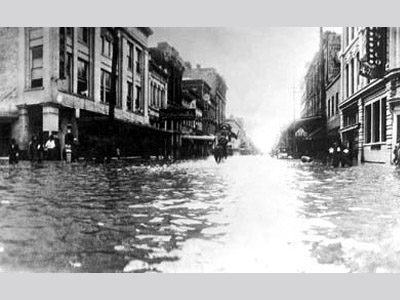Fifteen years after a devastating hurricane wrecked Galveston, TX, another monstrous hurricane formed in western Atlantic, again destined to strike the port city. The classic Cape Verde-type hurricane was officially detected on August 10, 1915, between the islands of Dominica and Barbados.
It was first described as a Category 1 hurricane, though it is thought to have held tropical storm status for five days previous. Moving westward, the hurricane passed to the south of Puerto Rico and the Virgin Islands on 11 August. Moving at about 32 km/h (20 mph), now in a northwesterly direction, the storm proceeded to impact the Greater Antilles and skimmed the northern coast of Jamaica on 12 August. On 14 August, the hurricane was close to Cuba’s Isle of Pines, having not been weakened by its recent interaction with land. Cuba was significantly impacted by the storm. The town of Cape San Antonio, on Cuba’s westernmost extremity, received heavy damage as the now Category 3 hurricane passed directly over it. The hurricane then tracked forward and steadily strengthened while doing so, having turned more northwesterly by the time it was over the central Gulf of Mexico on 15 August. By the time the hurricane was close to Texas, it had intensified to Category 4 status, displaying top winds of 217 km/h (135 mph). Very early on 17 August, the hurricane made landfall just to the southwest of Galveston, Texas at this peak intensity. The hurricane weakened quickly after landfall, downgrading to tropical storm status 12 hours later. After taking a sharp turn for the northeast over Texas, the storm proceeded to dump heavy rain as it moved across the United States causing damaging flash flooding in a range from Missouri to New York. Exact numbers for damage and deaths are not known. It finally dissipated over southern Quebec on 23 August. Texas residents, remembering the disastrous hurricane that struck their state 15 years earlier, said the power of this hurricane was equal to that of its predecessor and its duration twice as long. However, flooding was greatly hindered in Galveston by the construction of a new seawall following the catastrophic 1900 hurricane, even with a 4.9 m (16.2 ft) storm surge. Flooding of up to 1.8 m (6 ft) did occur in the city’s business district. Perhaps one of the greatest wind induced monetary loss came from the grounding or sinking of sea vessels. In Houston, damage totaled $1 million as most buildings received some sort of damage. All or most of the crops in the entire eastern half of the state were affected, especially the cotton crop where most was blown away or flattened by the rain. Corn and rice crops also suffered greatly from the wind and rain. Overall, the hurricane directly killed 275 people, with the possibility of up to 400 because of missing persons and an unknown death toll in Cuba. The hurricane caused $50 million (1915 USD) in damage. Fast Facts:
Sources:
Frankenfield, H.C. “The Tropical Storm of August 10, 1915.” Monthly Weather Review. August 1915. Pp 405-412. Web. “1915 Galveston hurricane.” Wikipedia. 2010. Web. “Hurricane 2 (08/05 – 08/23).” Weather Underground. Retrieved 2010. Web. Pielke, Roger A., Jr. et al. “Normalized Hurricane Damages in the United States: 1900-2005.” 6 Nov. 2006. Web. Roth, David. “Texas Hurricane History,” National Weather Service. 14 Jan. 2010. Pp. 34-35. http://www.hpc.ncep.noaa.gov/research/txhur.pdf “Deadliest U.S. Hurricanes.” Weather Underground. April 2007. Web. Roth, David. “Louisiana hurricane History.” National Weather Service. 14 Jan. 2010. Pp. 29-30. |


